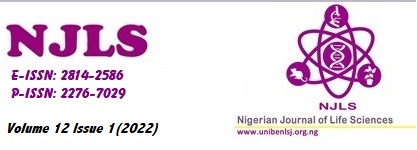PHYTOCHEMICAL PROPERTIES AND BIOTHERAPEUTIC POTENTIAL OF Thaumatococcus danielli Benn. ETHANOLIC LEAF EXTRACT
DOI:
https://doi.org/10.52417/njls.v6i1.293Keywords:
Bacteria, Antimicrobial properties, Thaumatococcus danielli, Phyto-compounds, Multi-drug resistant.Abstract
The biotherapeutic potential and phytochemical properties of ethanolic leaf extract of
Thaumatococcus danielli were determined in this study. Antibacterial sensitivity bioassay
was performed using the agar-well diffusion method. Staphylococcus aureus, Escherichia
coli, Bacillus subtilis and Streptococcus pyogenes were used as test organisms. Results
revealed varying antibacterial activity, with the extract having broad spectrum of activity and
being more effective against the Gram-negative bacteria than the Gram-positive bacteria.
Concentration of 100 mg/ml was most effective against the organisms, with E. coli. (27.00
0.66 mm) being the most susceptible. B. subtilis (12.66 0.57 mm), was the least
susceptible. The antibacterial activity was shown to be concentration-dependent. The
minimum inhibitory concentration (MIC) ranged from 12.50 mg/ml to 25.00 mg/ml while the
minimum bacteriocidal concentration (MBC) ranged from 25.00 mg/ml to 50.00 mg/ml. It
was also observed that B. subtilis had the highest MIC (25.00 mg/ml) and MBC (50.00
mg/ml). Antibiotic susceptibility test revealed that the test bacteria used in this research
were multi-drug resistant. Comparatively, the extract was more potent than the standard
antibiotics against the Gram-negative bacteria than the Gram-positive bacteria.
Phytochemical screening showed the presence saponins, tannins, alkaloids, and
flavonoids, which have antimicrobial properties. It is possible therefore, to use the ethanolic
leaf extract of T. danielli in the management of infections caused by the test bacteria.

Published
Issue
Section
License
Copyright (c) 2016 https://www.unibenlsj.org.ng/index.php/njls

This work is licensed under a Creative Commons Attribution 4.0 International License.





